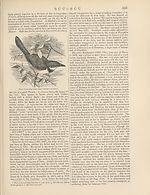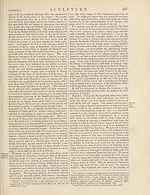Encyclopaedia Britannica > Volume 21, ROT-Siam
(566) Page 556 - Sculpture
Download files
Complete book:
Individual page:
Thumbnail gallery: Grid view | List view

556
Early
Chris¬
tian.
SCULPTUEE
THE present article is confined to tlie sculpture of the
Middle Ages and modern times; classical sculpture
has been already treated of under Arch/eology (Class¬
ical), vol. ii. p. 343 sq., and in the articles on the several
individual artists.
In the 4th century a.d., under the rule of Constantine’s
successors, the plastic arts in the Roman world reached
the lowest point of degradation to which they ever fell.
Coarse in workmanship, intensely feeble in design, and
utterly without expression or life, the pagan sculpture of
that time is merely a dull and ignorant imitation of the
work of previous centuries. The old faith was dead, and
the art which had sprung
from it died with it. In
the same century a large ' ^
amount of sculpture was
produced by Christian
workmen, which, though
it reached no very high
standard of merit, was at
least far superior to the
pagan work. Although
it shows no increase of
technical skill or know¬
ledge of the human form,
yet the mere fact that it
was inspired and its sub¬
jects supplied by a real
living faith was quite
sufficient to give it a
vigour and a dramatic
force which raise it aes¬
thetically far above the
expiring efforts of pagan¬
ism. Fig. 1 shows a very
fine Christian relief of
the 4th century, with a
noble figure of an arch¬
angel holding an orb and
a sceptre. It is a leaf from
an ivory consular dip¬
tych, inscribed at the top
AEXOY HAPONTA KAI
MA0^N THN AITIAN,
“Receive these presents
and having learnt the oc¬
casion ...” A number
of large marble sarco¬
phagi are the chief exist¬
ing specimens of this early
Christian sculpture. In
general design they are
Fig. 1.—Relief in ivory of the 4th
century. (British Museum.)
close copies of pagan tombs, and are richly decorated
outside with reliefs. The subjects of these are usually
scenes from the Old and Hew Testaments. From the
tormer those subjects were selected which were supposed
to have some typical reference to the life of Christ •
the Meeting of Abraham and Melchisedec, the Sacrifice
0 1®aac’ Daniel among the Lions, Jonah and the Whale,
are those which most frequently occur. Among the Hew
estament scenes no representations occur of Christ’s
sufferings; the subjects chosen illustrate His power and
beneficence : the Sermon on the Mount, the Triumphal
Jintry into Jerusalem, and many of His miracles are
Pilltf ™ exc®Ption to tllis is the scene of Christ before
Pilate, which sometimes occurs. e
frequently repeated. The Vatican and Lateran museums
are rich m examples of this sort. One of the finest in the
former collection was taken from the crypt of the old
basilica of St Peter; it contained the body of a certain
Junius Bassus, and dates from the year 359.2 Many
other similar sarcophagi were made in the provinces of
Rome, especially Gaul; and fine specimens exist in the
museums of Arles, _ Marseilles, and Aix; those found in
Britain are of very inferior workmanship.
In the 5th century other plastic works similar in style
were still produced in Italy, especially reliefs in ivory
(to a certain extent imitations of the later consular
diptychs), which were used to decorate episcopal thrones
or the bindings of MSS. of the Gospels. The so-called
chair of St Peter, still preserved (though hidden from sight)
in liis gieat basilica, is the finest example of the former
class; of less purely classical style, dating from about 550,
is the ivory throne of Bishop Maximianus in Ravenna
cathedral (see fig. 2). Another very remarkable work of
Fig. 2.—Reliefs in ivory of the Baptist and the Four Evangelists in
front of the episcopal throne of Maximianus in Ravenna cathedral.
the 5th century is the series of small panel reliefs on the
doors of S. Sabina on the Aventine Hill at Rome. They
are scenes from Bible history carved
in wood, and in them much of the
old classic style survives.3
In the 6th century, under the By- \ [ Byzan-
zantine influence of Justinian, a new tine-
class of decorative sculpture was pro¬
duced, especially at Ravenna. Sub¬
ject reliefs do not often occur, but
large slabs of marble, forming screens,
altars, pulpits, and the like, were
ornamented in a very skilful and ori¬
ginal way with low reliefs of graceful
vine-plants, with peacocks and other
birds drinking out of chalices, all
treated in a very able and highly Fig. 3.—Sixth-century
decorative manner (see fig. 3 and capital from S. Vitale
the upper band of fig. 2). Byzan- at Kaveuua-
tium, however, in the main, became the birthplace and
xlXT78™’ ^ YaL BaS' CV^'’ and Bunsen> Besch. d. Stadt
* Va]"10us dates have been assigned to these interesting reliefs by
different archaeologists, but the costumes of the figures are strong
evidence that they are not later than the 5th century.
Early
Chris¬
tian.
SCULPTUEE
THE present article is confined to tlie sculpture of the
Middle Ages and modern times; classical sculpture
has been already treated of under Arch/eology (Class¬
ical), vol. ii. p. 343 sq., and in the articles on the several
individual artists.
In the 4th century a.d., under the rule of Constantine’s
successors, the plastic arts in the Roman world reached
the lowest point of degradation to which they ever fell.
Coarse in workmanship, intensely feeble in design, and
utterly without expression or life, the pagan sculpture of
that time is merely a dull and ignorant imitation of the
work of previous centuries. The old faith was dead, and
the art which had sprung
from it died with it. In
the same century a large ' ^
amount of sculpture was
produced by Christian
workmen, which, though
it reached no very high
standard of merit, was at
least far superior to the
pagan work. Although
it shows no increase of
technical skill or know¬
ledge of the human form,
yet the mere fact that it
was inspired and its sub¬
jects supplied by a real
living faith was quite
sufficient to give it a
vigour and a dramatic
force which raise it aes¬
thetically far above the
expiring efforts of pagan¬
ism. Fig. 1 shows a very
fine Christian relief of
the 4th century, with a
noble figure of an arch¬
angel holding an orb and
a sceptre. It is a leaf from
an ivory consular dip¬
tych, inscribed at the top
AEXOY HAPONTA KAI
MA0^N THN AITIAN,
“Receive these presents
and having learnt the oc¬
casion ...” A number
of large marble sarco¬
phagi are the chief exist¬
ing specimens of this early
Christian sculpture. In
general design they are
Fig. 1.—Relief in ivory of the 4th
century. (British Museum.)
close copies of pagan tombs, and are richly decorated
outside with reliefs. The subjects of these are usually
scenes from the Old and Hew Testaments. From the
tormer those subjects were selected which were supposed
to have some typical reference to the life of Christ •
the Meeting of Abraham and Melchisedec, the Sacrifice
0 1®aac’ Daniel among the Lions, Jonah and the Whale,
are those which most frequently occur. Among the Hew
estament scenes no representations occur of Christ’s
sufferings; the subjects chosen illustrate His power and
beneficence : the Sermon on the Mount, the Triumphal
Jintry into Jerusalem, and many of His miracles are
Pilltf ™ exc®Ption to tllis is the scene of Christ before
Pilate, which sometimes occurs. e
frequently repeated. The Vatican and Lateran museums
are rich m examples of this sort. One of the finest in the
former collection was taken from the crypt of the old
basilica of St Peter; it contained the body of a certain
Junius Bassus, and dates from the year 359.2 Many
other similar sarcophagi were made in the provinces of
Rome, especially Gaul; and fine specimens exist in the
museums of Arles, _ Marseilles, and Aix; those found in
Britain are of very inferior workmanship.
In the 5th century other plastic works similar in style
were still produced in Italy, especially reliefs in ivory
(to a certain extent imitations of the later consular
diptychs), which were used to decorate episcopal thrones
or the bindings of MSS. of the Gospels. The so-called
chair of St Peter, still preserved (though hidden from sight)
in liis gieat basilica, is the finest example of the former
class; of less purely classical style, dating from about 550,
is the ivory throne of Bishop Maximianus in Ravenna
cathedral (see fig. 2). Another very remarkable work of
Fig. 2.—Reliefs in ivory of the Baptist and the Four Evangelists in
front of the episcopal throne of Maximianus in Ravenna cathedral.
the 5th century is the series of small panel reliefs on the
doors of S. Sabina on the Aventine Hill at Rome. They
are scenes from Bible history carved
in wood, and in them much of the
old classic style survives.3
In the 6th century, under the By- \ [ Byzan-
zantine influence of Justinian, a new tine-
class of decorative sculpture was pro¬
duced, especially at Ravenna. Sub¬
ject reliefs do not often occur, but
large slabs of marble, forming screens,
altars, pulpits, and the like, were
ornamented in a very skilful and ori¬
ginal way with low reliefs of graceful
vine-plants, with peacocks and other
birds drinking out of chalices, all
treated in a very able and highly Fig. 3.—Sixth-century
decorative manner (see fig. 3 and capital from S. Vitale
the upper band of fig. 2). Byzan- at Kaveuua-
tium, however, in the main, became the birthplace and
xlXT78™’ ^ YaL BaS' CV^'’ and Bunsen> Besch. d. Stadt
* Va]"10us dates have been assigned to these interesting reliefs by
different archaeologists, but the costumes of the figures are strong
evidence that they are not later than the 5th century.
Set display mode to:
![]() Universal Viewer |
Universal Viewer | ![]() Mirador |
Large image | Transcription
Mirador |
Large image | Transcription
Images and transcriptions on this page, including medium image downloads, may be used under the Creative Commons Attribution 4.0 International Licence unless otherwise stated. ![]()
| Encyclopaedia Britannica > Encyclopaedia Britannica > Volume 21, ROT-Siam > (566) Page 556 - Sculpture |
|---|
| Permanent URL | https://digital.nls.uk/193634637 |
|---|
| Attribution and copyright: |
|
|---|---|
| Shelfmark | EB.17 |
|---|---|
| Description | Ten editions of 'Encyclopaedia Britannica', issued from 1768-1903, in 231 volumes. Originally issued in 100 weekly parts (3 volumes) between 1768 and 1771 by publishers: Colin Macfarquhar and Andrew Bell (Edinburgh); editor: William Smellie: engraver: Andrew Bell. Expanded editions in the 19th century featured more volumes and contributions from leading experts in their fields. Managed and published in Edinburgh up to the 9th edition (25 volumes, from 1875-1889); the 10th edition (1902-1903) re-issued the 9th edition, with 11 supplementary volumes. |
|---|---|
| Additional NLS resources: |
|

